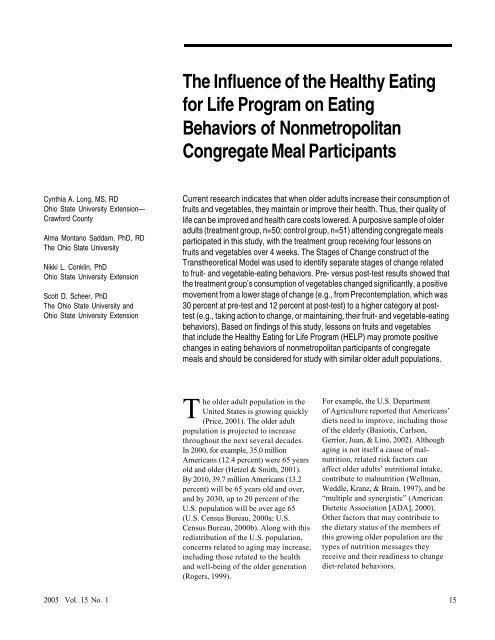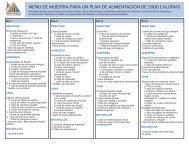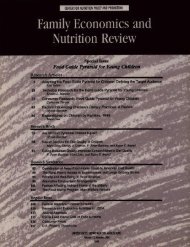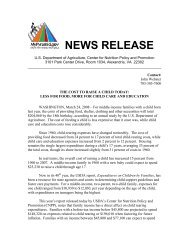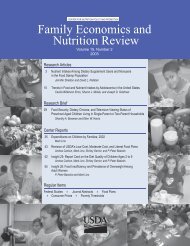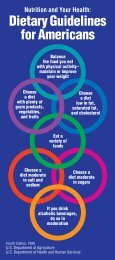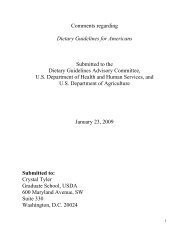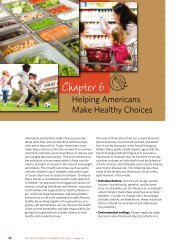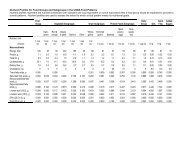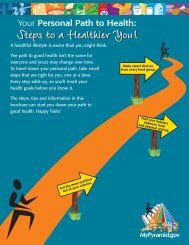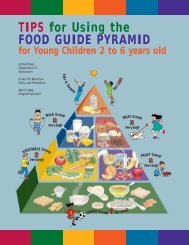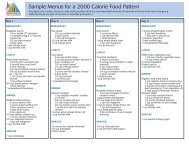Elderly Nutrition - Center for Nutrition Policy and Promotion - US ...
Elderly Nutrition - Center for Nutrition Policy and Promotion - US ...
Elderly Nutrition - Center for Nutrition Policy and Promotion - US ...
You also want an ePaper? Increase the reach of your titles
YUMPU automatically turns print PDFs into web optimized ePapers that Google loves.
The Influence of the Healthy Eating<br />
<strong>for</strong> Life Program on Eating<br />
Behaviors of Nonmetropolitan<br />
Congregate Meal Participants<br />
Cynthia A. Long, MS, RD<br />
Ohio State University Extension—<br />
Craw<strong>for</strong>d County<br />
Alma Montano Saddam, PhD, RD<br />
The Ohio State University<br />
Nikki L. Conklin, PhD<br />
Ohio State University Extension<br />
Scott D. Scheer, PhD<br />
The Ohio State University <strong>and</strong><br />
Ohio State University Extension<br />
Current research indicates that when older adults increase their consumption of<br />
fruits <strong>and</strong> vegetables, they maintain or improve their health. Thus, their quality of<br />
life can be improved <strong>and</strong> health care costs lowered. A purposive sample of older<br />
adults (treatment group, n=50; control group, n=51) attending congregate meals<br />
participated in this study, with the treatment group receiving four lessons on<br />
fruits <strong>and</strong> vegetables over 4 weeks. The Stages of Change construct of the<br />
Transtheoretical Model was used to identify separate stages of change related<br />
to fruit- <strong>and</strong> vegetable-eating behaviors. Pre- versus post-test results showed that<br />
the treatment group’s consumption of vegetables changed significantly, a positive<br />
movement from a lower stage of change (e.g., from Precontemplation, which was<br />
30 percent at pre-test <strong>and</strong> 12 percent at post-test) to a higher category at posttest<br />
(e.g., taking action to change, or maintaining, their fruit- <strong>and</strong> vegetable-eating<br />
behaviors). Based on findings of this study, lessons on fruits <strong>and</strong> vegetables<br />
that include the Healthy Eating <strong>for</strong> Life Program (HELP) may promote positive<br />
changes in eating behaviors of nonmetropolitan participants of congregate<br />
meals <strong>and</strong> should be considered <strong>for</strong> study with similar older adult populations.<br />
T<br />
he older adult population in the<br />
United States is growing quickly<br />
(Price, 2001). The older adult<br />
population is projected to increase<br />
throughout the next several decades.<br />
In 2000, <strong>for</strong> example, 35.0 million<br />
Americans (12.4 percent) were 65 years<br />
old <strong>and</strong> older (Hetzel & Smith, 2001).<br />
By 2010, 39.7 million Americans (13.2<br />
percent) will be 65 years old <strong>and</strong> over,<br />
<strong>and</strong> by 2030, up to 20 percent of the<br />
U.S. population will be over age 65<br />
(U.S. Census Bureau, 2000a; U.S.<br />
Census Bureau, 2000b). Along with this<br />
redistribution of the U.S. population,<br />
concerns related to aging may increase,<br />
including those related to the health<br />
<strong>and</strong> well-being of the older generation<br />
(Rogers, 1999).<br />
For example, the U.S. Department<br />
of Agriculture reported that Americans’<br />
diets need to improve, including those<br />
of the elderly (Basiotis, Carlson,<br />
Gerrior, Juan, & Lino, 2002). Although<br />
aging is not itself a cause of malnutrition,<br />
related risk factors can<br />
affect older adults’ nutritional intake,<br />
contribute to malnutrition (Wellman,<br />
Weddle, Kranz, & Brain, 1997), <strong>and</strong> be<br />
“multiple <strong>and</strong> synergistic” (American<br />
Dietetic Association [ADA], 2000).<br />
Other factors that may contribute to<br />
the dietary status of the members of<br />
this growing older population are the<br />
types of nutrition messages they<br />
receive <strong>and</strong> their readiness to change<br />
diet-related behaviors.<br />
2003 Vol. 15 No. 1 15


